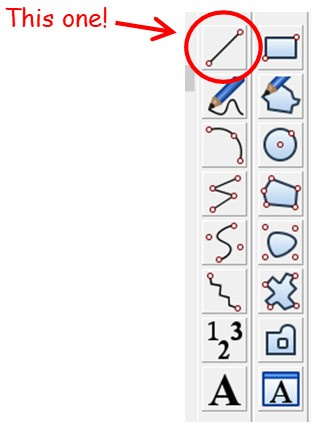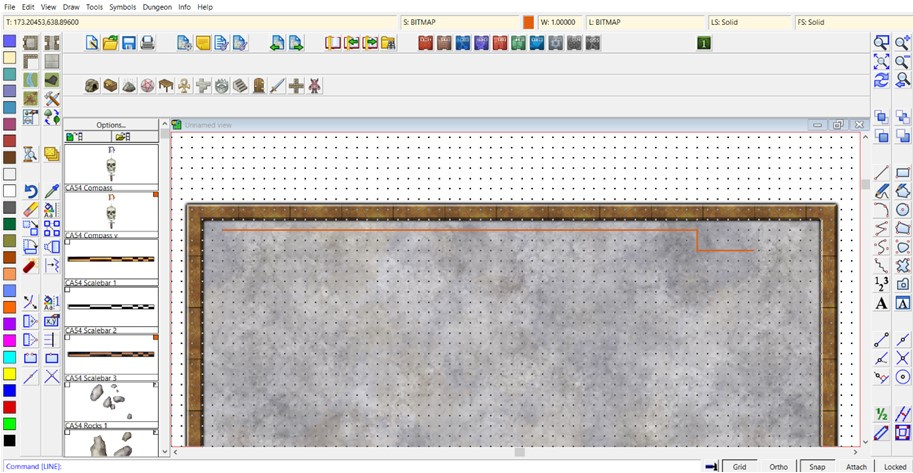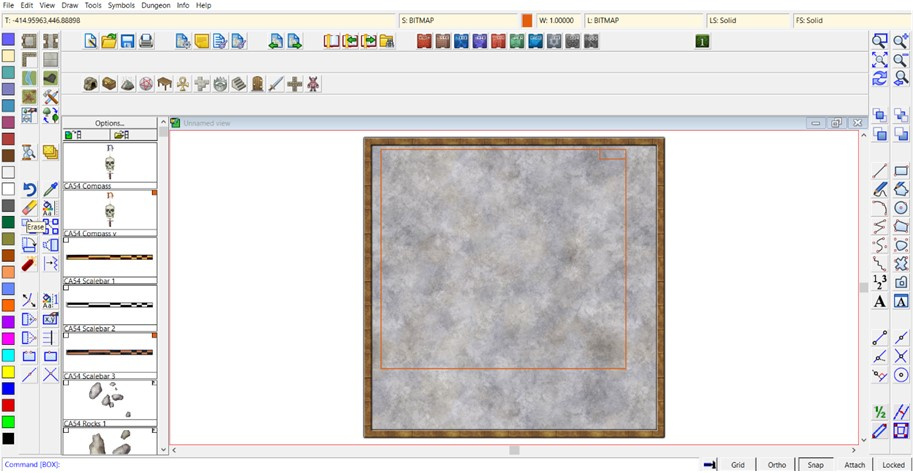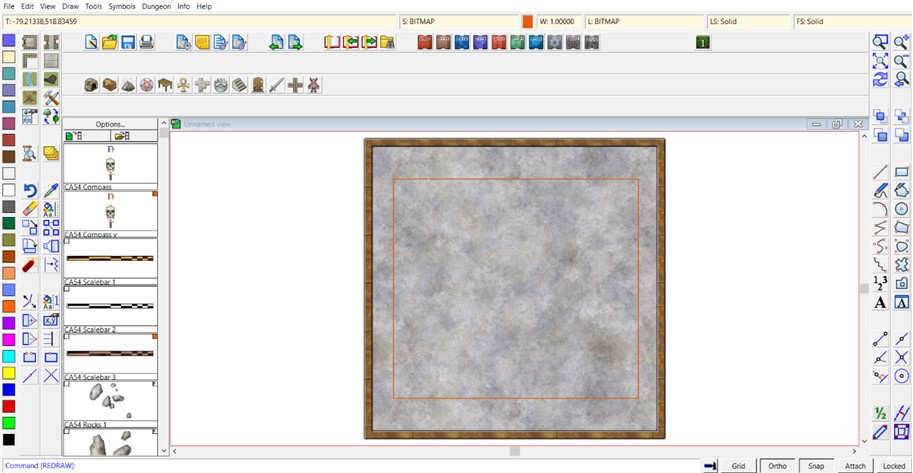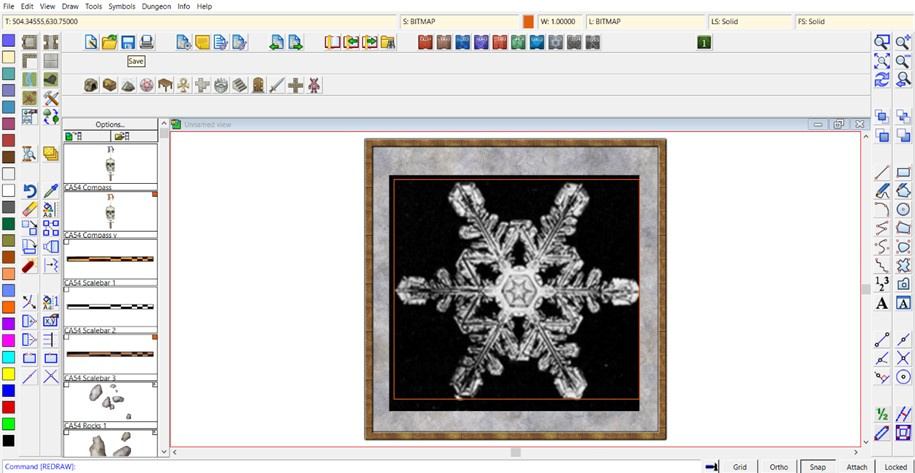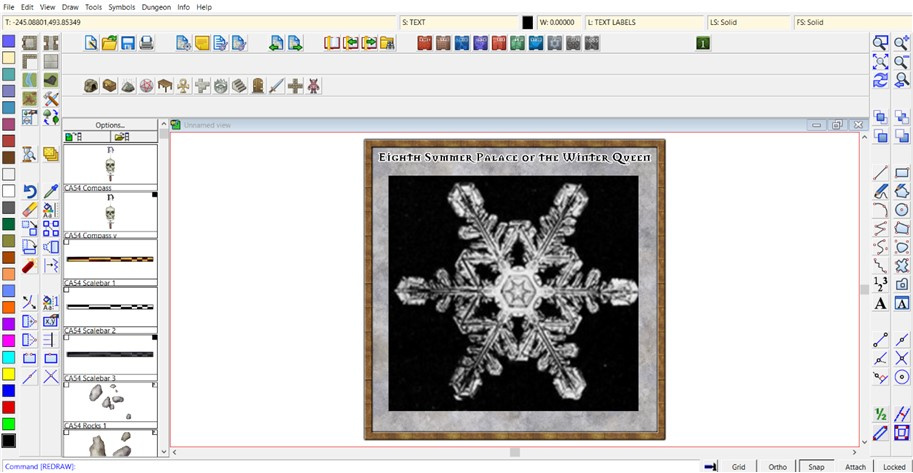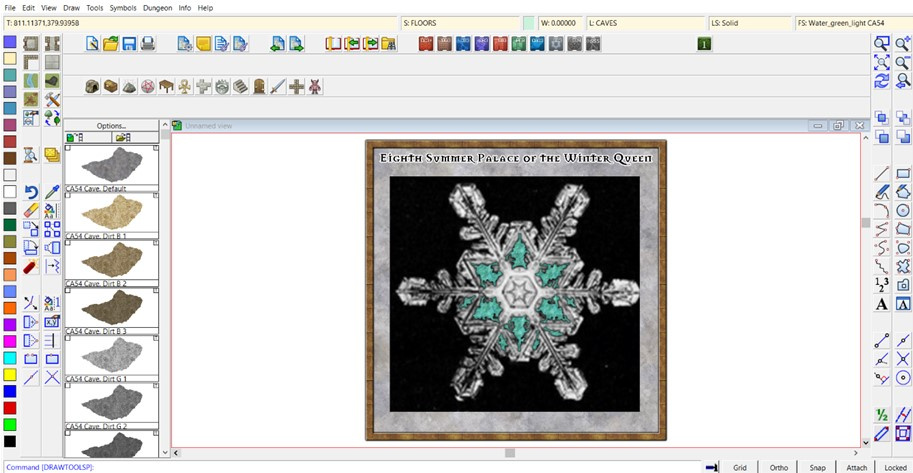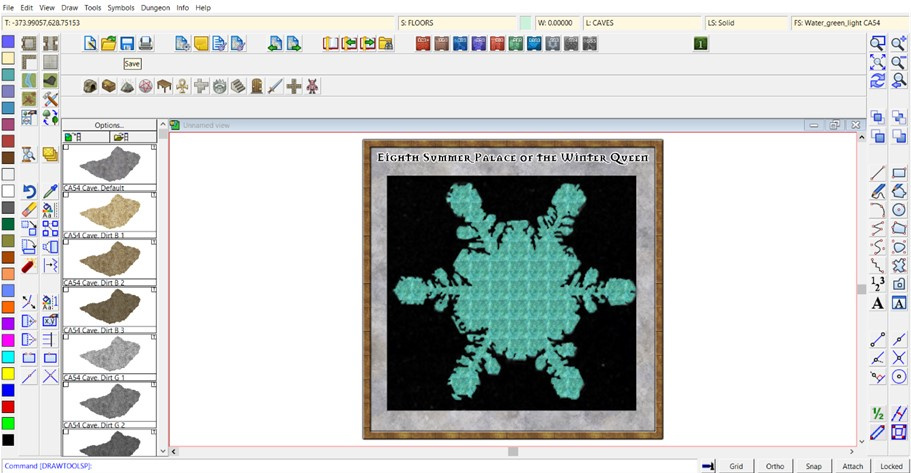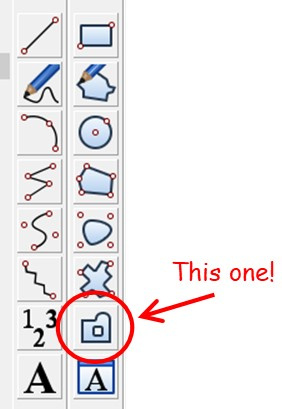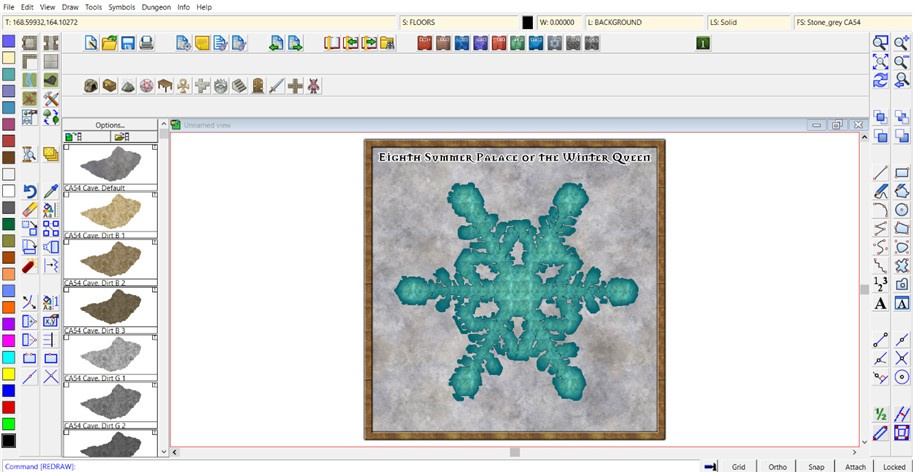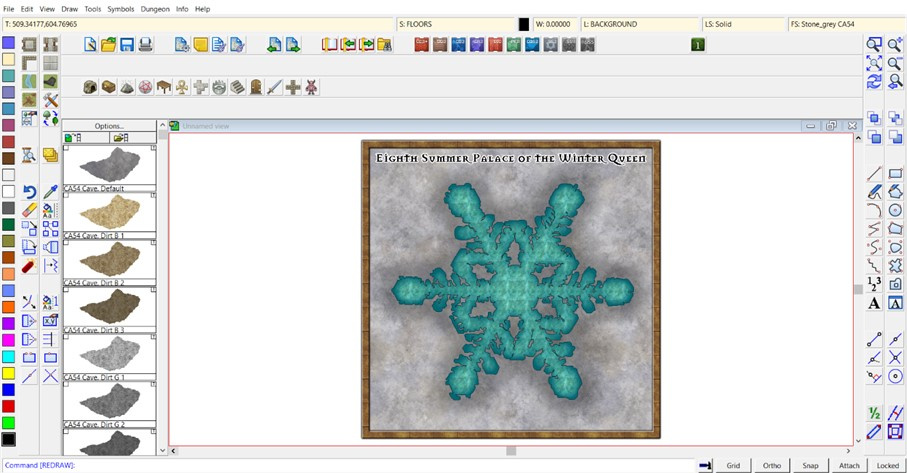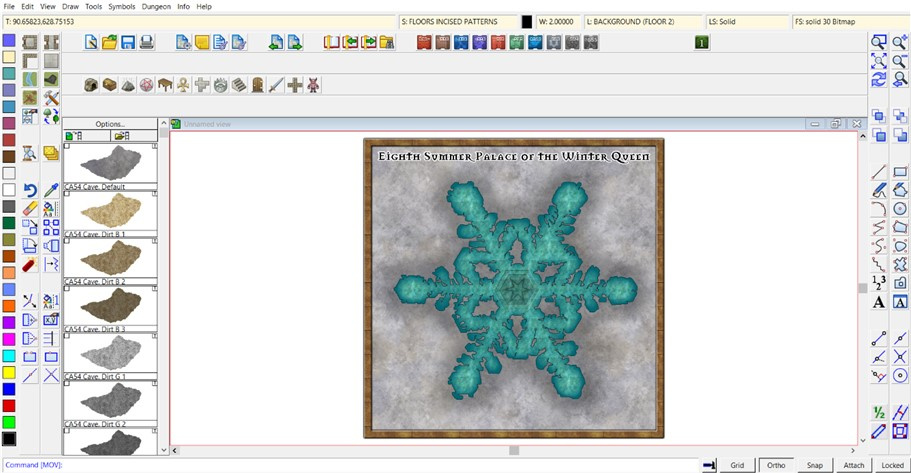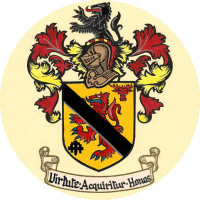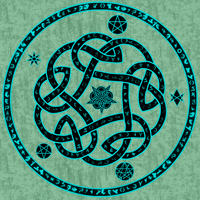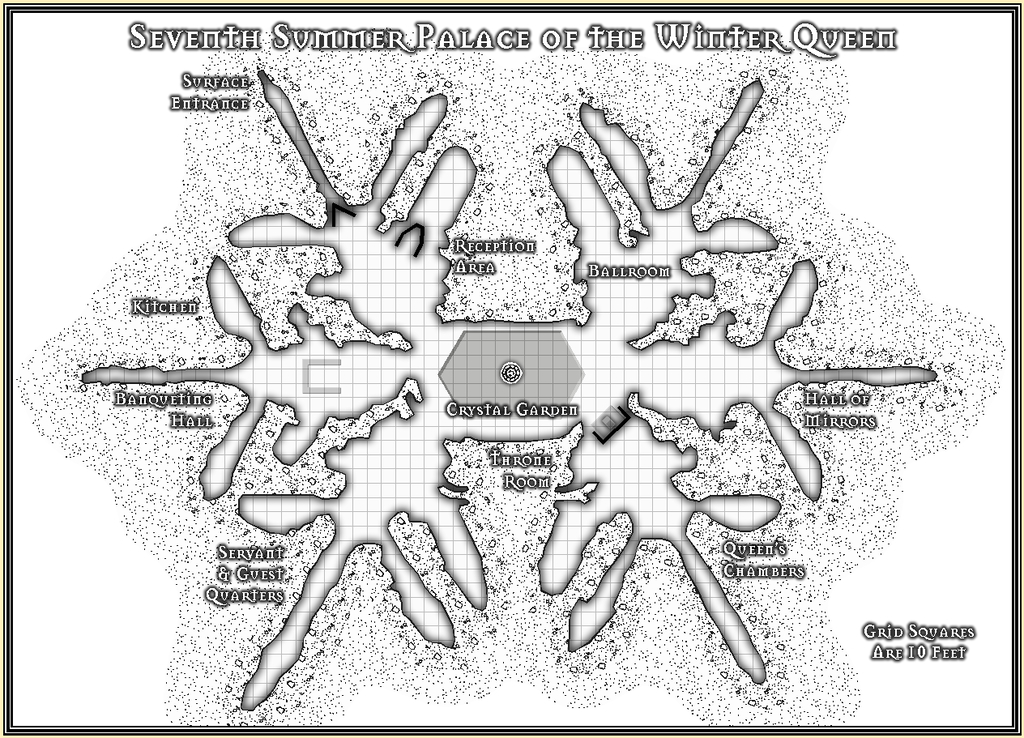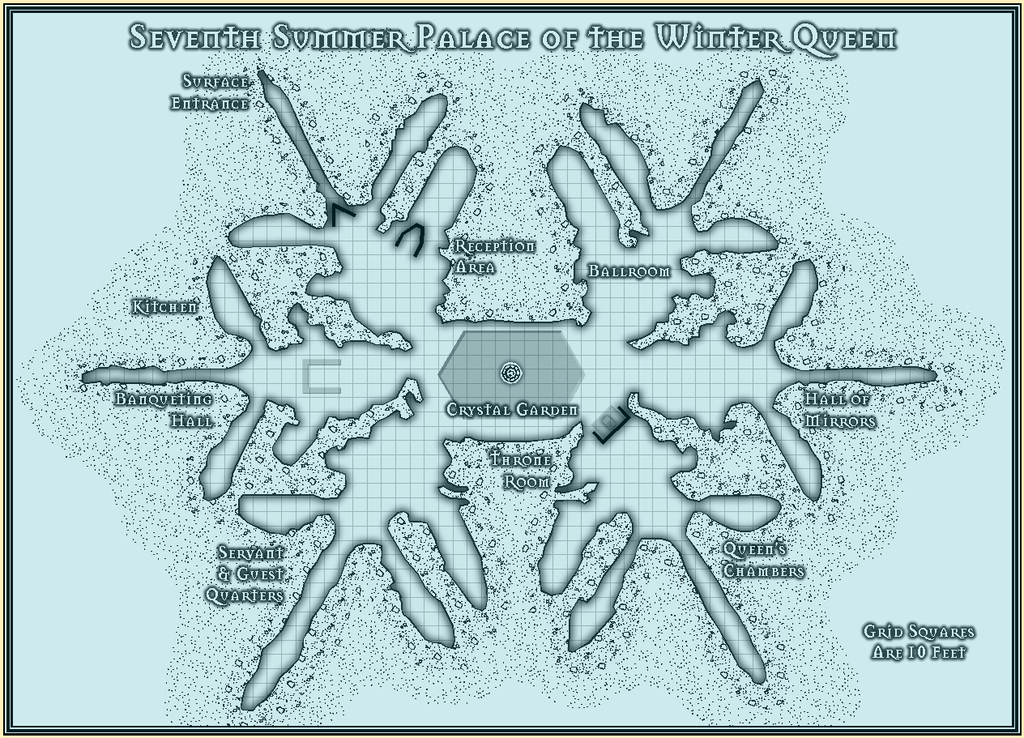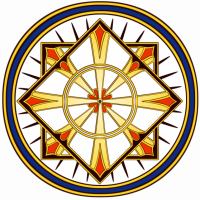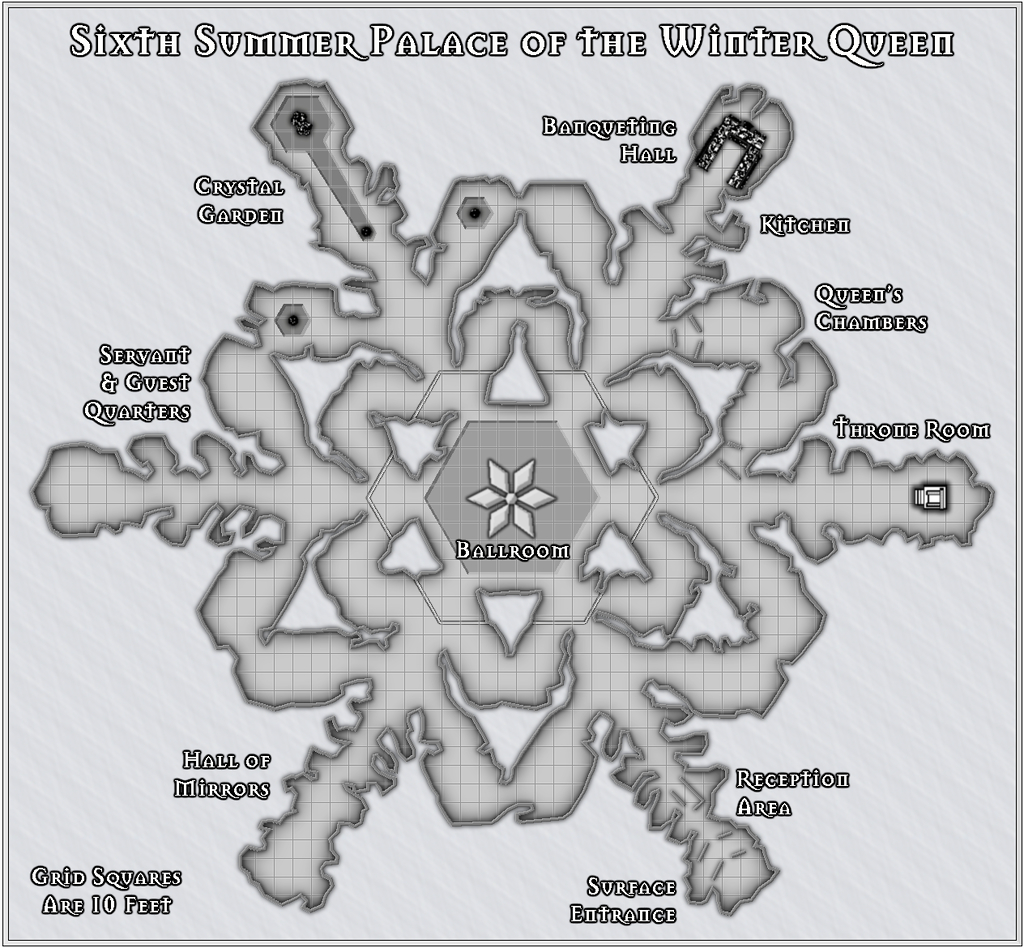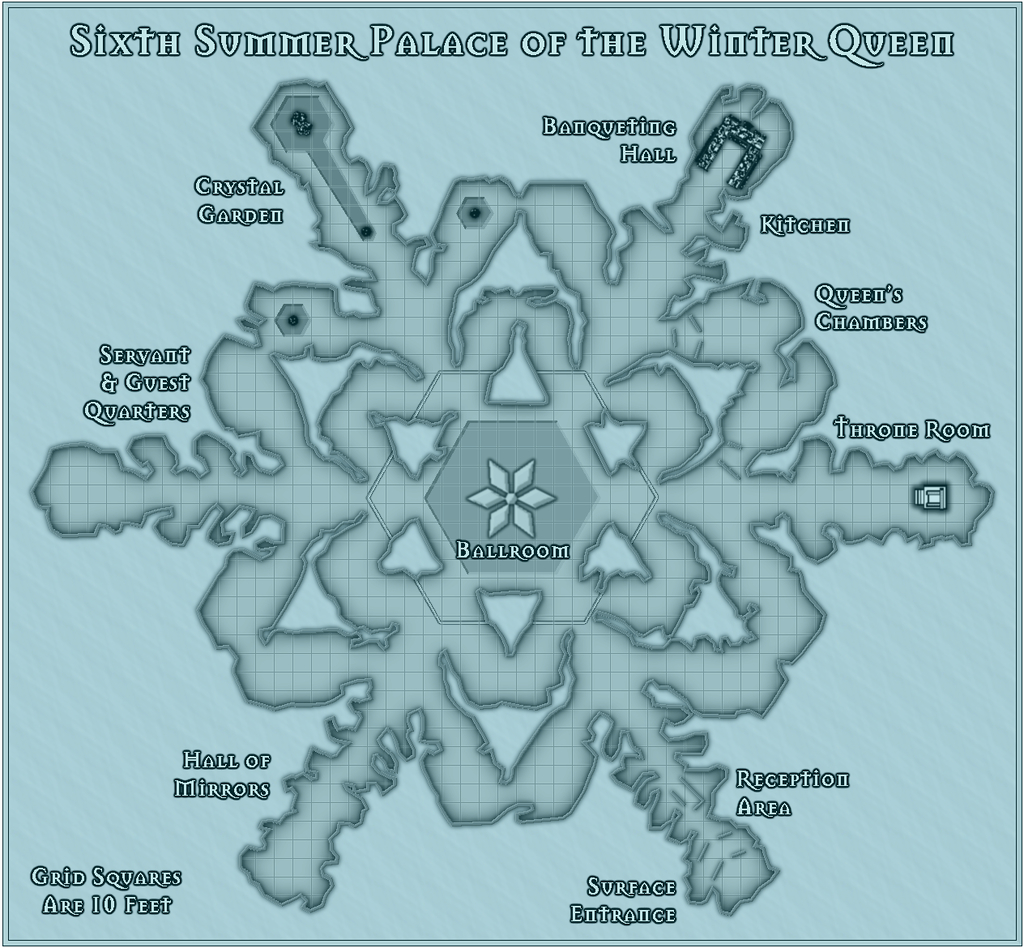
Wyvern
Wyvern
About
- Username
- Wyvern
- Joined
- Visits
- 3,129
- Last Active
- Roles
- Member
- Points
- 5,360
- Rank
- Cartographer
- Badges
- 24
-
Community Atlas competition entry: The Summer Palace of the Winter Queen
Bit of an excursus today. I've never really done full "works-in-progress" reports on the Forum here, chiefly because when I'm working on a map, I'm not thinking about anything else - such as how I've got to the point I have - which means taking screenshots or jotting down notes along the way so others might be able to follow the process is quite alien to me. However, a contest is nothing if not a chance to stretch beyond the expected bounds, so here are some thoughts on how I constructed the basis of Palace 8 in this series.
Partly, this came about because with working on such a series of similar yet different maps, each using an imported bitmap image as the template, I've established a pattern for doing so, drawing on previous experience, as a lot of my earlier mapping has involved copying layouts from images into CC3+.
Before even starting any of the maps, I'd picked the ten photo-micrographs of snowflakes I intended to use as the individual Palace shapes, and given them a number each, so I knew what order I'd be working on them. Then I printed-off copies of the ten. I like hard copies of such things to-hand, as it means I can jot notes on them in between mapping sessions, and can think more on the map design without having to be sitting at the computer. Additionally, they can be very handy while I'm tracing the image in CC3+, and find I've suddenly hidden some key item with a polygon that I now need to see!
These maps were always going to be a bit unusual, because what I'm doing is taking tiny, microscopically-imaged objects and expanding them to Palaces which are several hundred feet across. So there was a scaling issue from the start in that. However, looking over the images and deciding how the final Palaces were to be drawn, it was clear the key trait was going to be the minimum passage width, to allow access to all parts of the final structure. I fixed upon a general minimum width of 10 feet, from which I could then physically measure features on the hard-copy images, that in turn gave me the approximate maximum dimensions for the area each Palace would need to fit within, and hence roughly what the size of each map would need to be to allow for titling, labels and overall layout.
Palace 8's measured image meant the Palace itself was going to be around 515 feet by 460 feet, so I guessed that a map around 600 feet square might be OK. Firing-up CC3+, and having recently worked on three black-and-white style maps in succession, I opted for the Jon Roberts Dungeon style for Palace 8, from CA54, as a complete change. Aside from setting the size in the New Drawing Wizard, I wanted a paler background than the default to represent snow or grey-white ice, and went with the Stone Light Grey option from what the style offered.
Once the new map had opened, it was clear the fills for the map's frame and background needed adjusting to avoid the dreaded tiling effect, so I greatly increased both fill sizes using Tools - Set Properties - Fill Styles from the drop-down menus, after a bit of experimentation (and locating the correct fill style after picking the wrong one for the background first of all, and wondering why nothing happened when I adjusted it...).
After that, I created a new Sheet, BITMAP, and Layer, also imaginatively called BITMAP, into which I could import the map image. Now, placing and correctly rescaling such imported images is something I've long struggled with in CC3+, because of its restricted redraw standards, where most of the time, you can't see what it is you're trying to resize, or where its edges (which almost never coincide with the image edges) are going to land. So my trick now is to create a rectangular polygon with only a thin outer line in a bright colour, place that in the right spot on the map, and only then bring in the bitmap image. It isn't a perfect solution, but it's the one I've grown used to.
Of course, actually drawing the linear "box" is a bit of a nightmare in itself, because you can't just draw an open rectangle like this and tell CC3+ what size you want it to be as you might in a graphics program, or something even more basic, like Word. Instead it means counting dots on an appropriate-sized grid. For large areas like the Palaces, it's appallingly easy to lose track, so what I do is draw a single line with a kink in it, using the Line tool (not the Path one). For anyone unfamiliar it's:
That actually creates three separate lines, not just one. On the next image, the grid dots shown are those for the 10' Grid, 2 Snap (so the snap runs at five-feet intervals, with the dots every ten feet), and the lines are in orange:
Then I rotate the longer line (that at the left side here) through -90° from its left-most point. (This is because CC3+ insists on doing angles backwards, not logically clockwise! We've discussed this on the Forum before. There are good mathematical-programming reasons for CC3+ doing so, which if nothing else will convince you that mathematics has very little to do with reality after all ?). And then draw a new linear box of the right size, using that left-most point as its top left corner, and the construction lines as templates to give the right size overall:
Then the construction lines can be deleted, and the new box moved to a more central position, again using the snap grid dots as a guide (not shown here, as the image size meant you could scarcely see where the box was any more with the grid left on):
After which, using the Draw - Insert File command from the drop-down menus, the correct snowflake bitmap image can be brought in, resized and correctly positioned, using the construction line box (and a fair amount of adjusting and tweaking):
The box can also then be deleted. Sometimes, I draw in one or two crossed centre-lines like this as well, as they're useful for adding items such as the title, if it's meant to be centred somewhere near the map's periphery. Which means at this point I also often add the map's title, so I can remove all the construction lines together. (If they might be needed again later, I usually set them up on their own Sheet in the first place, so they can be hidden or called back at any stage.) In this case though, the title is long enough it's not hard to centre it without needing that:
Next up is to start the mapping proper, by drawing the floor. Looking at the image, it's clear there are several areas where the floor should be missing in the final version, within the outermost line of the flake, so I'd already decided with this mapping style, that would be best accomplished using a Multipoly command on the completed outer floor. This is easier by drawing the areas of floor that will eventually be omitted first, and although it's not so useful for seeing all the pieces you've drawn just before going to the Multipoly action, I like to use the same fill style as the final floor will be, mainly so I don't forget later... Thus:
I really liked that Water Green Light fill in the Jon Roberts style, as representing here ice instead. Just has the right colouring and texture to me to give a magical "zing" to the whole. It is a magical ice Palace, after all. You get a better impression of it once the whole outer floor's drawn:
And yes, the tiling's very obvious here. While that could be changed, it'll be much less obvious on the finished drawing, so I left it alone, and just carried out the Multipoly command at this stage:
After which it was time to consider adjusting the Effects on the Floors Sheet:
and adding the central floor design based on what the imported image showed, using the Solid 10 to 30 fills, which have the perfect level of transparency to still let the underlying "ice" floor show through, even after adding a suitable Bevel Effect to make them look sunken into said floor, after one of Remy Monsen's recent blog posts about using such Effects:
Beyond which, it should be just a matter of adding other smaller details, labels and a grid. While I'd love to show you what the final map looks like, that will have to wait for another time, as the amount of time and effort involved in putting these notes together meant I didn't manage to get the map itself finished in time to post it today as well!
Starting to remember why I don't do "proper" WIP threads here now... ?
-
Community Atlas competition entry: The Summer Palace of the Winter Queen
As is fairly obvious, I quickly settled on a standard set of seven areas for each Palace map. It is essentially the same Palace each time of course, just with a different design and layout to keep things interesting. Thus I thought some further notes extracted from the forthcoming PDF texts might be an appropriate additional level of explanation here, following on from the general notes last time.
The air throughout the Palace is always fresh and calm regardless of conditions immediately outside the Entrance. While cool, it is of an equitable temperature for whoever physically enters it (something which can feel different for every entrant). The atmosphere is ordinarily solemn and slightly saddening, as if coloured by the ephemeral nature of summer, coupled with the presence of the many passing souls. Ceiling heights, while variable as befits an apparently natural crystalline ice form, are rarely less than 15 to 20 ft (4.5 to 6 m), typically of angular, sometimes spectacular, vaulted nature.
Regardless of its form, there are always seven major areas within the Palace: A guarded Surface Entrance and Reception Area, through which all must first pass, whether physical, immaterial, living or dead; A Ballroom for parties and entertainments; A Banqueting Hall for feasting and its adjoining Kitchen; A Crystal Garden rich with more summer ice-flowers; A Hall of Mirrors of ice; A range of Servant & Guest Quarters; and A Throne Room with the Queen's Chambers nearby.
Surface Entrance: Surrounded by a small garden of summery ice-flowers and foliage, the entrance is always a low, point-topped, open archway around 5 ft tall by 3 ft wide (1.5 by 0.9 m) set in a back-sloping wall of ice. The ice-plants are placed on both this wall and the more level surface just in front of it, always with a cleared path leading a little indirectly to the Entrance, a little wider than the archway. This platform, wall and arch are present even when the Palace is set in the clouds, as they are parts of the Palace itself. The Palace cannot be entered by any means in any other way. Pushing physically into the surrounding clouds, or digging into the ice beyond wall or platform finds no trace of the Palace, for instance, while magical transportation devices and spells will not function into or out from the Palace. Someone who has died in the right environment or circumstances will have their soul pass through here at some stage, although the timing is always uncertain, and usually inconsistent with that in the physical world. Equally, the dead have no control over when or for how long they may be here. Once through the archway, the Palace opens-up immediately as mapped, and the entrant finds themselves at the start of the Reception Area.
Reception Area: This commonly has several awkward, narrow places in it, sometimes with separate ice-walled chambers as well. There are physical guards of various kinds, many to most of magically-animated ice construction, often armed and armoured with ice that has the properties of magically-empowered metal. More typical arctic-environment intelligent creatures may be encountered here at times as well. The numbers involved are always more than a physical group could overcome, and fresh ice-constructs will simply manifest from the ice whenever required. Such constructs are rather like antibodies inside a living creature, whose numbers increase to match the level of the invading threat. This means such constructs may appear from any ice surfaces elsewhere in the Palace in response to threats too. A few guards may be incorporeal spirits, souls temporarily on the Palace's staff, and if so, they may be known to whoever has just entered. This latter is always intentional.
Ballroom: A large, open area for entertainments. When in use, temporary low ice platforms may grow from the floor for performers or an orchestra, say (often made up of passing souls), along with features such as tables and seats with refreshments. Glittering lighting effects, enhanced beyond the Palace norms, can be employed here too. Most guests are normally disembodied spirits, thus the events can have a sombre tone, rather more wake than party, for instance. A literally haunted ballroom.
Banqueting Hall: A substantial ice-table, commonly of angular "C" or "U" shape, is the dominant fixed feature, with fixed ice seats - usually benches - alongside it, and a larger throne-like chair for the Queen at the table's head. Despite most guests at the feasts here being spirits, any physical guests will find the food and drink of excellent quality, albeit the food is exclusively bread and the drink fresh water. However, the bread has an array of forms that include many typical loaf types, and more made to look like meats and fruits. Each has a hint of the taste its appearance would suggest. The bread provides better sustenance than meals of greater variety found elsewhere, and has mildly healing properties for those in need of it, in addition. Similarly, the water comes in an array of different temperatures, colours and tastes, again with beneficial effects that complement the healing powers of the bread. All the tableware is of exquisitely-fashioned ice, while still possessed of a strength and durability closer to metal and pottery than ice. Even the spirits can partake of the food and drink, using the utensils as normal, though only so long as they are seated at this table.
A Kitchen area either adjoins or is close-by the Banqueting Hall. This contains a physical, if seemingly much too small, bread oven, materials and workspaces suitable for preparing bread. The Queen may be here at times, physically making the bread. She prepares all of it daily.
More to follow (if nobody complains this isn't sufficiently map related, at least)!
The bread concept came about largely because of a paper in the latest issue of the journal Folklore, "Winter Crones and Bread-Givers: The Northern Iberian Vieya" by Cristobo de Milio Carrín (can't provide a link, sorry; the journal's subscription-only currently, though you can find a free-access version of the paper's abstract on Semantic Scholar here), which caught my attention recently. It seemed appropriate, particularly as I wanted to keep things minimalist overall, hence the bread & water theme.
-
Community Atlas competition entry: The Summer Palace of the Winter Queen
On a roll, so Palace 7 was also done with a black-and-white style package, this time the Inked Dungeons one from CA160 last April, the first time I've used this. I must admit I wasn't too sure about it at first, as it uses a quite "busy" looking fill to mask the outside of the subterranean walls. However, when I selected the various snowflake images for the Palace designs, this flake was probably the most obvious to pick, because it looked so different to many of the others, as elongated on one axis. That in turn set me thinking about larger ice crystals, as the central Crystal Garden area here was a single huge ice crystal on the original image, so far as I could tell. So now this Palace has unusually large ice crystals visible along and buried in its translucent outer walls as well, simply because the style pack set me thinking while I was drawing the map!
In addition, Inked Dungeons comes with relatively few symbols, which isn't so much of a problem with these large-area Palace drawings, since as I've noted above, there can be problems where the symbols have too much interesting surface detail from other style packs. So I used only one, actually designated as a brazier, but repurposed here as its opposite - the fountain in the Crystal Garden - and just drew the few other more obvious features, as has been the case for many of the other Palaces.
The final step once more was to offer the option of a simple blue cover to colour the whole map, as previously, intended to be a toggle option in the Atlas version, and as with Palace 6, added using a blue rectangle with a strong Transparency Effect. Because it stops me panicking when I open the file and find it's just a blank white emptiness otherwise (see the Palace 5 notes above!).
-
Community Atlas competition entry: The Summer Palace of the Winter Queen
As mentioned a couple of days ago, aside from the mapping, I've also been pulling together the notes to accompany this set of maps, so for those who might be interested to know more in advance, here are the general comments from the start of that file, as drafted to date.
No one is quite sure who or what the Winter Queen really is. The rare tales mentioning her suggest she may be a deity or an exceptionally powerful, probably immortal, perhaps Faerie, creature. Few such tales give useful details on her nature, though many cultures in the higher northern and southern latitudes of Nibirum preserve variants or fragments of the stories, where the Queen has numerous alternative, typically apotropaic, local titles. It is clear she is thought to possess great magic, much exceptionally obscure knowledge, and a considerable burden. Humanoid in form, she appears as very tall (around 8 or 9 feet high; 2.4 to 2.7 metres), dressed in a long, hooded robe, with piercing blue eyes, bearing a long white staff or crook taller than she is, and an air of great sadness. Her clothing and physical features are said to alter subtly from one day to the next.
She cannot leave the Palace, and has no control over where it goes, as the Palace moves magically, and instantly, once a day to a new location. It is said to be never in exactly the same place twice, but its location is always in an icy, remote, spot, concealed below the surface. Its solitary entrance, while small and hard to find, has no door (there are no doors throughout the Palace), and can be recognised by the profusion of perfect representations of summer flowers and foliage all around it, made of crystal-quality ice. This summer array of perfect specimens is astonishingly beautiful, all of which objects are very fragile. Damaging any is a swift way to raise the Winter Queen's ire, something the tales strongly warn against.
Wherever the Palace alights and for fifty miles around (eighty kilometres), the weather worsens and turns wintry, if it was not winter when it landed. Sometimes, it settles in the clouds, where it stirs them to winter storms, pouring hail and snow down to the surface beneath in icy gales. Even then, the Palace remains deeply hidden by the clouds, for all it still has its ice-flower-surrounded single entrance.
While some tales allude to it, one reality about the Palace is that the souls of all who have died recently in the frozen places of the world, and all those who have died from cold elsewhere, must pass through it on their way from wherever they were to wherever they may be going. A few may linger in the Palace for a time, and some may become temporary guests or servants of the Winter Queen. The Queen has no control over which may stay or move on immediately, however. She frequently converses with those passing through even so, from which much of her secret knowledge derives. Occasional tales may hint disparagingly that the Queen is merely running a ferry service for the recently deceased.
The Palace changes its form whenever it moves, never the same twice, though always in plan-view having the shape of a gigantic snowflake, with walls, floor and ceiling composed entirely of solid, if at least slightly translucent, crystal-like ice. This is always beautiful, with glittering facets like gems that reflect light on or just within the solid ice surfaces. Somehow, light palely manages to illuminate the whole interior with a soft radiance, no matter how deeply buried the Palace may appear to be. At times, rainbow-coloured beams, arcs and spots may be seen, like haloes in the outdoor sky that are created by refraction of sunlight through tiny hexagonal ice-crystals in thin, high-altitude, clouds. Sometimes such light effects may become dazzlingly bright briefly. The ice walls, floors and ceilings reflect light as well, which in places can take on a mirror-quality surface. Such mirrors can allow glimpses of past or future events and places, memories left by the passing spirits, perhaps. The Winter Queen does have some control over such light, vision, visionary and illusory effects within the Palace.
Queen and Palace are so inseparable because in essence, they are parts of the same thing. Many of the Queen's "servants" are actually living ice-constructs which appear from, and can return into, the inner ice surfaces of the Palace as required, thus too are simply another element of this whole being.
-
Community Atlas competition entry: The Summer Palace of the Winter Queen
Palace 6 (that's over halfway!) is another black-and-white map, using the CA48 Black & White Dungeons style. This time, I chanced using a few of the symbols that come with the style, mostly because I liked the throne, and didn't want to just have that one symbol on its own. So we have actual fountains in the Crystal Garden for once, and a set banqueting table, with seats, for the Banqueting Hall (not the clearest in this low-res image, I appreciate). I also did a little more decoration for the floor of the huge central Ballroom, primarily because the forms were on the original snowflake image, and I thought the floral design especially worked well with the overall concept of the Summer Palace idea. Plus that outer large hexagonal line forms a neat border to the Ballroom itself. As last time, the first map is the B&W version, the second one where I've added some blue iciness, this time in the form of a simple blue coloured covering rectangle with a strong Transparency Effect on it. Again, if all goes to plan, this should be available via a toggle in the Atlas version.
Whereas Palace 5 used a simple drawn polygon for the floor outline, with the internal wall-blocks on that drawn and set up using walls and floor masks on Sheets above the floor one, here, the floor was done as a multipoly, after drawing in the internal walls first, and copying them to the floor sheet before carrying out the command. And treble-checking I wasn't going to need to do more with it later, given you can't adjust nodes on a multipoly later!
Despite which, if you check very hard in the FCW file, you will find one spot where I had to add a new floor patch because one of the walls had grown just a bit too spiky... Isn't it always the way?



